
Wood Fuel Scarcity in the Sahel and the Potential of Solar Cookers
Let me fist propose the core of my argument in thesis form.
Thesis 1:
- A part of the consumption of wood energy in the Sahel is unsustainable, i.e. it is not compensated by new growth of woody biomass.
Thesis 2:
- Renewability – or sustainability – has to be proved and defined in geographical terms, i.e. in relation to a given area or region, by comparing consumption and production of woody biomass.
Thesis 3:
- Electricity as final energy – whether produced from renewable sources or not – is not a realistic alternative for biomass as far as cooking is concerned.
Thesis 4:
- Solar cookers can help to bring wood consumption down to sustainable levels.
Limits of renewability
Wood is basically a renewable energy – in principle at least. Whether this is so in practice, depends on the maintenance of a balance between consumption and production of woody biomass. But this balance has been upset in many countries or areas. For this reason, renewability – or sustainability – of wood fuel resources has to be defined in a geographical context, not in the abstract. If this precaution is not taken, errors are unavoidable. An example of this type of error is the country brief “Chad” [1] of the American Energy Information Administration (EIA), where it is said that “Wood is the primary source of total energy in Chad”. The same document, however, states “fuel share of energy consumption: oil 100 %” and “fuel share of carbon emissions: oil 100 %”.
This contradiction may be explained by two facts:
- The mission of the EIA is to observe the global energy market. But wood energy is not traded internationally. The EIA has therefore little interest in wood energy.
- The EIA neglects the geographical context necessary for the meaningful use of the underlying concept of renewability of wood resources.
The real role of different form of final energy may be seen from Fig. 1:
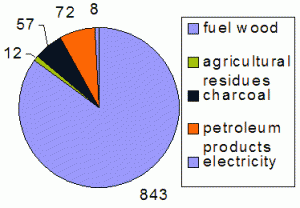
Figure 1. Share of different forms of energy in final energy consumption in Chad 1995, in thousand tons oil equivalent, according to data from Household Energy Programme, Staff Appraisal Report (HEP/SAR 1998), World Bank[2].
The EIA authors seem to presume that carbon emitted from wood combustion is entirely taken up by forest stands and thus removed from the atmosphere. But under conditions of deforestation, degradation of forest stands and desertification this is no longer true everywhere. In fact, a part of wood consumption varying from area to area is not replaced by new growth and thus unsustainable.
Effects of the overexploitation of wood resources on the African environment
Especially in Africa wood surfaces have declined considerably, as ma y be seen from Fig. 2.
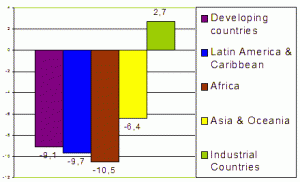
Figure 2: Change of wood surfaces between 1980 and 1995, according to “Africa Environment Outlook”, UNEP 2002[3].
In most regions of the world forest surfaces have decreased between 19980 and 1995, except in industrial countries, where there has been an increase. This is due to the fact that they do not depend on wood energy, and that for non-energy purposes they can rely on the forests of non-industrialized countries. Consumption of forests as fuel does not only increase carbon emissions, but implies also the disappearance of vegetation and soil as a carbon sink. If we look into the change of wood surfaces per head in Africa, the loss is even bigger: from 1.22 to 0.74 hectare/inhabitant.
The likely increase in the consumption of biomass – about 65 % of which are wood fuels – and the role of households in this consumption can be seen in Fig 3.
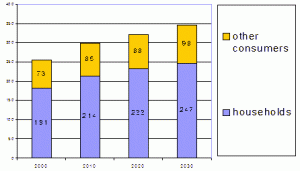
Fig 3. Consumption of biomass in Africa between 2000 and 2030, in million tons oil equivalent (Mtoe), according to data of the “World Energy Outlook”[4], International Energy Agency (IEA) 2002.
Prices and access to energy
Biomass is still the cheapest form of energy in Chad. This is extremely important, because 64 % of the population live below the poverty line[5]. Each step upwards the “energy ladder” means at least a doubling of cost.
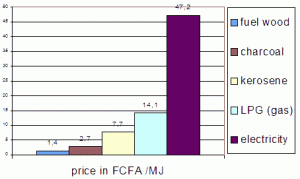
Figure 4: Prices of different fuels compared on the basis of equal energy content Francs CFA per Mega-Joule, according to data from HEP/SAR, World Bank.
We see that electricity is by far the most expensive form of energy. It is comprehensible that people avoid to use it for energy-intensive purposes like cooking. Moreover, only less than 1 % of the population of Chad had access to the grid in 1995.
UNEP states in the World Energy Outlook [2002]: “there is a widespread misconception that electricity substitutes for biomass. Poor families use electricity selectively – mostly for lighting and communication devices. They often continue to cook with wood or dung, or with fossil-based fuels like LPG and kerosene”. This is certainly equally true for electricity from renewable sources.
Charcoal, the provisioning of towns and cities and climate aspects
As we have seen in figure 1, wood and charcoal account for the bulk of cooking energy. Charcoal is becoming more and more important because it is easier to transport than wood to urban centres and because it produces less fume when cooking than wood. The problem is that charcoaling is usually done with very low efficiency – of only 13 % on a weight basis – in Chad. That means that 1 kg of wood leads to 0.13 kg of charcoal. With improved techniques 20 % efficiency can be obtained. Under laboratory conditions, 0.31 kg of charcoal are possible. The actual 13 % efficiency, expressed the other way round, means that conversion from wood of charcoal needs 7-8 kg of wood as primary energy to produce 1 kg of charcoal. This loss is only partly compensated by the higher energy density of charcoal, which is about double that of wood.
But there are also climate aspects of charcoaling. Low efficiency of conversion means increased carbon emissions into the atmosphere[6], see Fig 5. Carbon is emitted in the form of CO2, CO and CH4 (Methane). Of these, Methane is of particular importance as it has a high Global Warming Potential (GWP), which is about 21 times that of CO2, calculated over a period of 100 years.
As we have seen, charcoal is relatively cheaply transported over long distances, and is increasingly preferred by urban dwellers. The annual increase in consumption in Chad is about 8 %. The problem is compounded by quick urbanization of 7 % per year. Studies in other countries have also shown an association between growth in charcoal consumption and urbanization. The World Bank expects an increase in the off-take of wood in the N’Djamena area from 410000 to 730000 tons [2]. A internet publication of PREDAS (Programme Régional de Promotion des Énergies Domestiques et Alternatives au Sahel)[7] puts it like this: “The provisioning of towns and cities is the motor of the fuelwood crisis in the Sahel”.
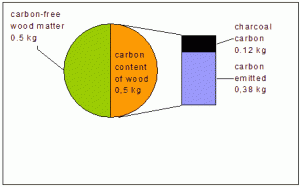
Fig 5. Carbon content of wood and its split into two compartments: charcoal and emissions. The efficiency of charcoaling in this example is 13 %, carbon content of charcoal 90%.
In Kenya, the production and transport of charcoal has been made illegal, but not selling, buying and using it. Violet Matiru and Stephen Mutimba[8] write: “Kenya’s schizophrenic charcoal policies have forced the industry underground, but the trade is too massive to stop. The criminalization of production and transport has done nothing to stem the growth in demand, especially in urban areas, but it has sown fertile ground for corruption”.
A study commissioned by the European Union and the Food And Agriculture Organization of the United Nations (FAO) states[9] : “in several (African) countries the situation of supply and demand has reached a critical point – or approaches it – which corresponds to a scenario, in which the poorest are deprived of their most elementary goods. In several countries, per-head consumption is falling because of diminishing supply and rising prices … The consumption of charcoal alters the relation between the energetic needs of households and wood resources in the region and transforms what had always been accepted as a way of self provisioning – namely the collection of wood for fuel – into an infernal circle with potentially dramatic effects on wood and forests.”
Making the best of urbanization
Earlier attempts to disseminate solar cookers have generally been targeted at the rural population. But the rural population consumes less wood than townspeople, and nearly no charcoal. Rural dwellers usually still have the possibility to collect firewood, and they see no need to incur expenses, the more so as poverty is mainly rural. Townspeople, on the other hand, have to buy fuel for cooking. They feel energy prices – especially price increases – and are thus more inclined to consider possible alternatives, like solar cookers. More often than the rural population, the are able to invest. Attempts at dissemination of the solar cooker technology should therefore address the urban population in the first place, especially those families using charcoal as their preferred or secondary energy source. This undertaking is made easier by shorter distances and by the generally higher literacy rate in towns[10] [11].
Researchers in Burkina Faso found that the possession of “assets” like mopeds, radios, sewing machines and so on is inversely related to poverty[12]. Solar cookers should be presented as an asset, with the additional advantage of making the family less vulnerable to fuel price increases.
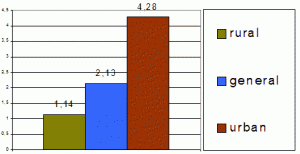
Figure 6: Expected population growth rate in West Africa by sectors, based on data of the West Africa Longterm Prospective Study (WALTPS) commissioned by OECD/Club du Sahel: “Preparing for the Future: A Vision of West Africa in the Year 2020″[13].
We see that the population in urban areas is increasing about four times as quickly as in the countryside, and two times quicker than the general population.
Energy invested and energy harvested by solar cookers
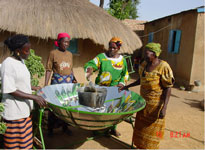
Solar cooker use in Sarh, Chad (Photo: Désirée Nguekadjita, Sarh).
Emission reductions through substitution of charcoal by solar cookers
The quantity of charcoal in the above mentioned example – 0.05 kg per person – was manufactured from 0.35 to 0.4 kg of wood as primary energy. This latter quantity, together with the quantity of wood used directly (0.89 kg) – minus the amount of wood that has replaced charcoal (0.1kg) – brings the wood consumption up to 1.14 kg/person (35.65 MJ), and 11.4 kg for a family of ten.
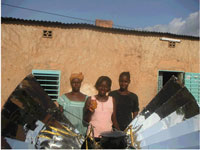
The papillon in a compound in Ouagadougou. Here it is used to make mango marmalade for sale (Photo. Horst Meyer)
Solar cookers and jobs
Experience in Burkina Faso shows, that two workmen can make one solar cooker per day. Allowing for time off work, this would be equivalent to 250 cookers per year. Making one hundred thousand solar cookers would mean the creation of 800 jobs. About 30 % of the end price represents cost of labour. Supposing a consumer price of 175 Euro – as in Burkina Faso – the cost of labour per cooker would be 52.5 Euro, that is 26.25 Euro per workman.
Promotion of solar cookers
As we have seen, solar cooking can contribute not only to find a way out of the household energy crisis, but also to contribute to solving other development problems. But solar cooking needs active promotion. This is best done by local civil society organizations. Cooking demonstrations are a useful means of familiarizing the population with the handling of solar cookers.
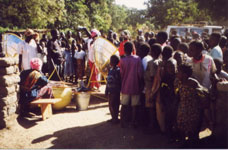
Photo 3: Solar Cooking demonstration on a market in Burkina Faso (Photo P. Krämer)
Sources of information used:
- Energy Information Administration (EIA) Country Brief ‚Chad’ (2001), http://www.eia.doe.gov/emeu/cabs/chad.html.
- Weltbank, “Staff Appraisal Report (SAR), Household Energy Project, Republic of Chad”, World Bank Document 17780-CD, May 4, (1998), http://www-wds.worldbank.org/servlet/WDSContentServer/IW3P/IB/1999/09/17/000009265_3980624143048/Rendered/PDF/multi_page.pdf.
- United Nations Environmental Programme (UNEP): “Africa Environment Outlook”, Stevenage (Hertfortshire) 2002
- International Energy Agency : “World Energy Outlook 2002”, chapter 13: “Energy & Poverty”, http://www.worldenergyoutlook.org/media/weowebsite/2008-1994/weo2002_part1.pdf
- The World Bank Group: “Chad at a glance”, http:/www.worldbank.org/data, 9/21/01, (2001).
- W. Floor und R. van der Plas: “CO2-Emissions by the Residential Sector: Environmental Implications of Inter-fuel Substitution”, Weltbank, Industry and Energy Department, Energy Series Paper No. 51, (1992), http://wwwds.worldbank.org/servlet/WDS_Ibank_Servlet?pcont=de tails&eid=000009265_3961002175510
- Programme Régional des Énergies Domestiques et Alternatives au Sahel (PREDAS), www.cilssnet.org/predas/energie_sahel.htm
- V. Mutiru, und S. Mutimba: “Legalise it”, in: “Hot and Dirty. Inside Kenya’s 23 billion shilling charcoal industry”, Ecoforum, Nairobi 25/4 p.34-35 (2002).
- [9] R. Drigo, “Information sur l’énergie ligneuse en Afrique”, Projet GCP/RAF/354/EC – Programme de partenariat CE – FAO (2000-2002), document de travail, 2001, www.fao.org/forestry/FOP/FOPH/Energy/doc/InfoEnergy.pdf
- P. Krämer : “Solarkocher : ja oder nein?”, epd-Entwicklungspolitik 15, p. 36-38, (2002).
- B. Hafner, W. Heinzen und P. Krämer : “Solarkocher. Grundlagen, Praxis, sozio-ökonomische und sozio-ökologische Betrachtungen”, Münster-Sarmsheim (2002).
- H. Fofack, C. Monga, H. Tuluy: Household Welfare and Poverty Dynamics in Burkina Faso: Empirical Evidence from Household Surveys, Policy Research Working Paper, The World Bank, Africa Region, WPS 2590 (2001), elibrary.worldbank.org/doi/abs/10.1596/1813-9450-2590
- J.-M. Cour, und S. Snrech, “Preparing for the Future. A Vision of West Africa in the Year 2020, West African Long Term Prospective Study” (WALTPS), OECD / Club du Sahel, Paris (1998).
- Aluminium Recycling GmbH (Felixdorf, Austria): Allgemeines zu Aluminium, www.alurec.at/allgemein.html
- Haut Comité Pour l’Environnement, République du Tchad,”Convention Cadre des Nations Unis Contre les Changements Climatiques, Communication Nationale Initiale”, Août (2001), http://unfcc.int/resourde/docs/natc/chanc1 pdf.
- P. Krämer: “Die Holzknappheit im Sahel und das Potential der Solarkocher”, Gaia, Ecological Perspectives in Science, Humanities and Economics 3/2003, p.208-214.
- K. Kuhnke, M. Reuber, D. Schwefel: “Solar Cookers in the Third World”, Braunschweig/Wiesbaden 1990.



